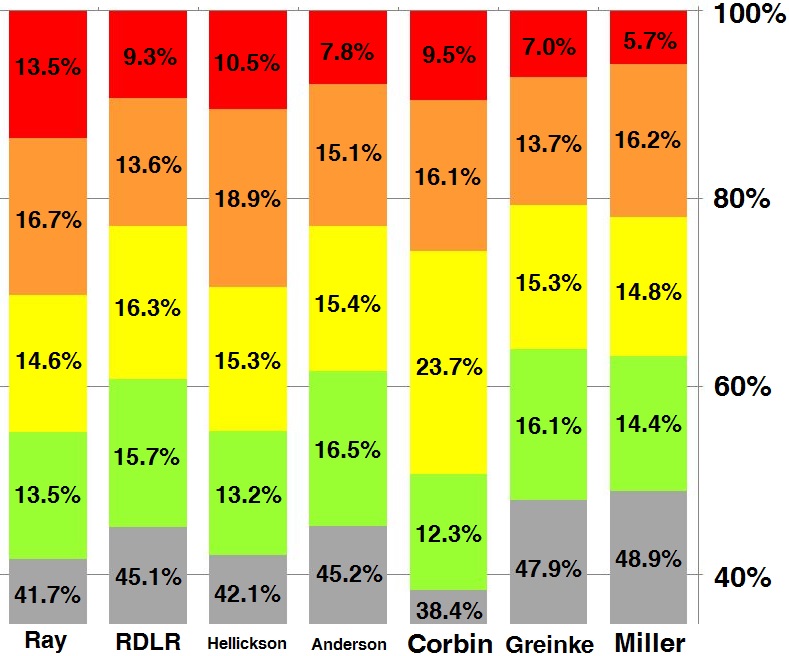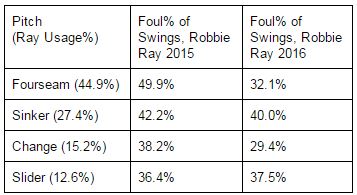Robbie Ray Getting More Efficient
Last season, Robbie Ray seemed to balance on the edge of a knife. He lived on the edge of the zone to his arm side, tantalizing hitters with fastballs that normally they could drive — if only they didn’t have Ray’s tremendous arm-side run, carrying them even farther outside. When “The Slurge” was delivered, you couldn’t help but lose your breath until the outcome was secure. And more than anything else: Ray had great success getting hitters to two strikes, and not nearly as much success putting them away after that.
Ray’s Foul% was unusual in 2015, and that’s the whole point. Hitters couldn’t quite square him up, and yet with two strikes in particular, Ray had trouble forcing an end to the plate appearance. After a string of foul balls, he might finally throw enough pitches too far outside the zone for a hitter to swing, issuing a free pass. On the one hand, not getting squared up was Ray’s strength. On the other, better contact might have been better for Ray, if it had resulted in more easy outs.
Ray is one of the many D-backs pitchers to have added (or relied more on) a sinker in 2015, a pitch that for him was less about “sink” and more about a different kind of arm-side run. It was his second-most-frequent pitch in 2015, even though he threw just 2 in his first start and 10% in his first full month. In his six months in the majors (including one start in May and one in October), his sinker percentage grew from 2.2% all the way to 36.4%, increasing at least five basis points in every month.
Unlike those of most of the other D-backs pitchers last season, Ray’s sinker worked — very well. Batters had a .232 average on the pitch, and Ray held their slugging percentage on it to an excellent .326. By slugging, it was far and away Ray’s finest offering, and it was a big reason to think he could keep up his 2015 performance in 2016.
The thing is: it didn’t help Ray’s foul ball predilection, at least not that much. See what I mean:
The sinker was the least foul-ball-iest of his pitches, at least as compared to league average, but its foul% was still quite a bit higher than average. And of the 54 pitchers who threw at least 1,000 fourseam fastballs in 2015, Ray’s foul% ranked him 4th-highest, and the top lefty (of 14) by far. And it’s not like they weren’t squaring him up: of 286 tracked balls with exit velocities, a whopping 29.7% left the bat at 100+ mph, when the chances of a hit are roughly 70%. Of last year’s main five starters (and Zack Greinke and Shelby Miller), Ray had the highest percentage of 105+ mph exit velocity (red), the highest percentage of 100+ mph velocities (red and orange), and one of the lowest percentages of 89 mph or below velocities (gray, which also includes non-tracked balls, which generally are weaker):

Considering his difficulty in putting guys away, a not-very-good batted ball profile and control that was not much to write home about (3.45 BB/9), why did Ray do so well last year when so many others struggled? A big part of it was strikeouts (8.39 K/9), but another big piece of the puzzle was a surprisingly low home run rate (0.63 HR/9). That latter point is the reason why Ray’s FIP (3.53) very closely matched his actual ERA (3.52), but his xFIP was not nearly as good (4.03).
Ray gave up 9 home runs in 127.2 innings last year, a very low rate that is all the more bizarre in that every one of the three changeups he threw in September were hit for home runs. Side point, but… wow.
In Ray’s first start of the year, though, just 9 of his 97 pitches were fouled off, a microscopic (for Ray) rate of 25% of swings that resulted in foul balls. But we aren’t necessarily talking about just one game — we also have three spring training games that were tracked by PITCHf/x, and with 263 tracked pitches, things get a little more interesting. Compare Ray’s 2015 foul/swing rates (from above) with what we’ve seen from him so far in 2016:
What’s really interesting: that foul% in 2 strike counts so far this year is substantially improved: just 26.7% of pitches overall, and 44.4% of swings. Compare that with the real problem last year: Ray threw 690 2-strike pitches in 2015, an incredible 211 of which were fouled off. That’s 30.6% of pitches overall, and a crazy 50.5% of swings. You didn’t imagine it: batters just wouldn’t die last year when Ray had them on the ropes. Things aren’t necessarily a whole lot better, but they at least look better.
And the bottom line: he has been more efficient. So far in 2016, Ray has thrown 15.9 pitches per inning, just a hair above average, but a monstrous improvement from his 17.7 pitches per inning rate in 2015. He’s accomplished that in an unconventional way.
This may partly be a function of spring training being what it is, but only 34.6% of pitches Ray has thrown so far this season have been in the PITCHf/x strike zone, as I read it from Brooks Baseball. That’s incredible. Baseball Prospectus has Ray’s Zone Rate at 49.1% last season, although I should mention that using the same PITCHf/x strike zoneat Brooks, I get his zone percentage to be 39.2%.
However you slice it, Ray has been pitching out of the zone more in 2016, which has, surprisingly, made him more efficient. For most pitchers most of the time, pitching outside the zone means more called balls, which means longer at bats — and more walks. Ray has walked batters at a higher rate — 4.50 BB/9, instead of 3.45 BB/9 — but he’s cut down on foul balls. With two strikes, in particular, it’s as if Ray is more willing to err on the side of walks than risk a steady stream of foul balls. Swing and miss, or don’t swing, it seems like.
With two strikes, Ray’s pitches have been in the zone just 28% of the time so far this year, in what’s been tracked by PITCHf/x — and I get a 36.7% figure for the 2015 season. No, we’re not talking about a ton of pitches here, but this is enough for it to seem deliberate. It may be that by flirting with the edges of the zone, Ray would always get those very high foul percentages. For a pitcher who already throws outside the zone more than average, being told to be more efficient as Ray was in the spring could very easily turn into throwing in the zone substantially more. But Ray may always get hit hard when he pitches in the zone; he seems to be the very opposite of a contact manager. So far this year, Ray’s answer has been to throw out of the zone even less. Let’s see if that keeps up — and if that keeps working.
One Response to Robbie Ray Getting More Efficient
Leave a Reply Cancel reply
Recent Posts
@ryanpmorrison
 Best part of Peralta’s 108 mph fliner over the fence, IMHO: that he got that much leverage despite scooping it out… https://t.co/ivBrl76adF, Apr 08
Best part of Peralta’s 108 mph fliner over the fence, IMHO: that he got that much leverage despite scooping it out… https://t.co/ivBrl76adF, Apr 08 RT @OutfieldGrass24: If you're bored of watching Patrick Corbin get dudes out, you can check out my latest for @TheAthleticAZ. https://t.co/k1DymgY7zO, Apr 04
RT @OutfieldGrass24: If you're bored of watching Patrick Corbin get dudes out, you can check out my latest for @TheAthleticAZ. https://t.co/k1DymgY7zO, Apr 04 Of course, they may have overtaken the league lead for outs on the bases just now, also...
But in 2017, Arizona ha… https://t.co/38MBrr2D4b, Apr 04
Of course, they may have overtaken the league lead for outs on the bases just now, also...
But in 2017, Arizona ha… https://t.co/38MBrr2D4b, Apr 04 Prior to the games today, there had only been 5 steals of 3rd this season (and no CS) in the National League. The… https://t.co/gVVL84vPQ5, Apr 04
Prior to the games today, there had only been 5 steals of 3rd this season (and no CS) in the National League. The… https://t.co/gVVL84vPQ5, Apr 04 RT @OutfieldGrass24: Patrick Corbin has a WPA of .318 and it's only the fifth inning., Apr 04
RT @OutfieldGrass24: Patrick Corbin has a WPA of .318 and it's only the fifth inning., Apr 04
Powered by: Web Designers@outfieldgrass24
 RT @JonHeyman: In astros talks for Goldy, JB Bukauskas and Cionel Perez were in play. D-Backs took the surer bet and more diversif… https://t.co/t2CyKbOA4j, 12 hours ago
RT @JonHeyman: In astros talks for Goldy, JB Bukauskas and Cionel Perez were in play. D-Backs took the surer bet and more diversif… https://t.co/t2CyKbOA4j, 12 hours ago Tarik Cohen is so fast he just tackled himself, 5 hours ago
Tarik Cohen is so fast he just tackled himself, 5 hours ago RT @JCGonzalezOR: Special thanks to @HillsboroHops for hosting a LatinX community outreach and visioning session. This organization i… https://t.co/OxmEgwOpEh, Dec 08
RT @JCGonzalezOR: Special thanks to @HillsboroHops for hosting a LatinX community outreach and visioning session. This organization i… https://t.co/OxmEgwOpEh, Dec 08 Old friend alert https://t.co/xwSHU0F8Hn, Dec 08
Old friend alert https://t.co/xwSHU0F8Hn, Dec 08 Every once in a while you get a beer that's just a little off... Usually happens to me at airports., Dec 07
Every once in a while you get a beer that's just a little off... Usually happens to me at airports., Dec 07
Powered by: Web Designers







[…] In the early going, it looked a whole lot like Ray was dealing with foul ball woes very well: […]